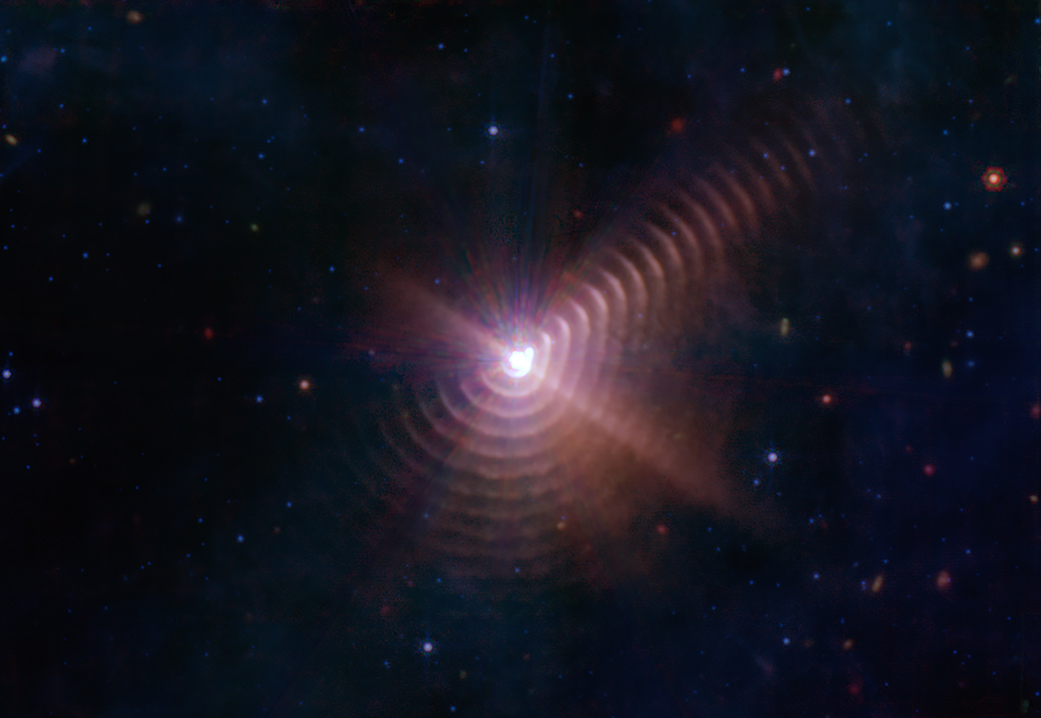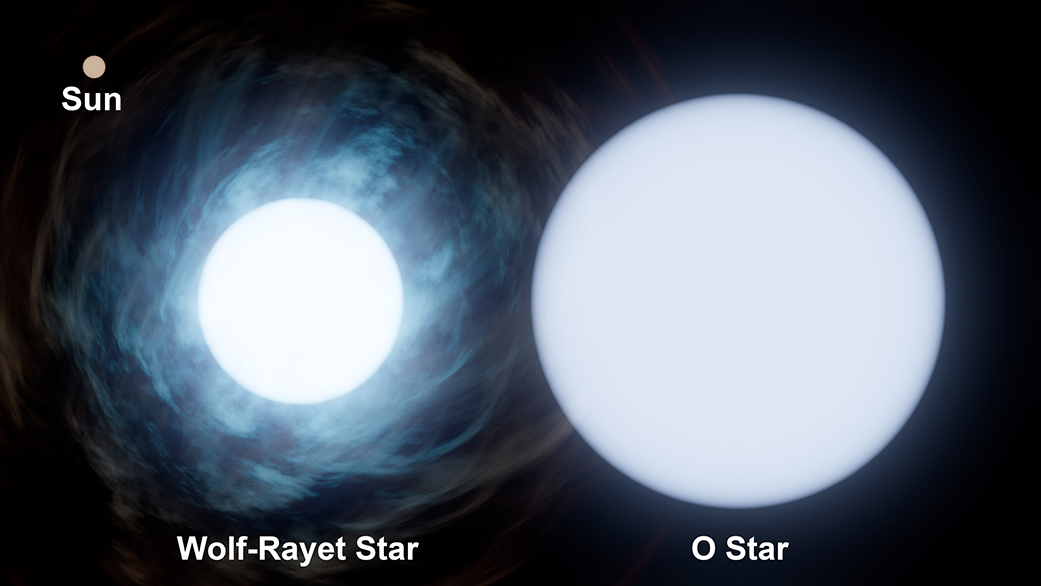
A new image shows at least 17 dust rings created by a rare type of star and its companion locked in a celestial dance.
3D print of the WR 140 image, designed for those with blindness or visual impairment
Learn why Webb has the coldest camera in space
Read about Webb’s first observation of an exoplanet atmosphere
A new image from NASA’s James Webb Space Telescope reveals a remarkable cosmic sight: at least 17 concentric dust rings emanating from a pair of stars. Located just over 5,000 light-years from Earth, the duo is collectively known as Wolf-Rayet 140.
Each ring was created when the two stars came close together and their stellar winds (streams of gas they blow into space) met, compressing the gas and forming dust. The stars’ orbits bring them together about once every eight years; like the growth of rings of a tree’s trunk, the dust loops mark the passage of time.
“We’re looking at over a century of dust production from this system,” said Ryan Lau, an astronomer at NSF’s NOIRLab and lead author of a new study about the system, published today in the journal Nature Astronomy. “The image also illustrates just how sensitive this telescope is. Before, we were only able to see two dust rings, using ground-based telescopes. Now we see at least 17 of them.”
In addition to Webb’s overall sensitivity, its Mid-Infrared Instrument (MIRI) is uniquely qualified to study the dust rings – or what Lau and his colleagues call shells, because they are thicker and wider than they appear in the image. Webb’s science instruments detect infrared light, a range of wavelengths invisible to the human eye. MIRI detects the longest infrared wavelengths, which means it can often see cooler objects – including the dust rings – than Webb’s other instruments can. MIRI’s spectrometer also revealed the composition of the dust, formed mostly from material ejected by a type of star known as a Wolf-Rayet star.
Credits: NASA, ESA, CSA, STScI, JPL-Caltech
MIRI was developed through a 50-50 partnership between NASA and ESA (European Space Agency). The Jet Propulsion Laboratory in Southern California led the effort for NASA, and a multinational consortium of European astronomical institutes contributed for ESA.
A Wolf-Rayet star is an O-type star, born with at least 25 times more mass than our Sun, that is nearing the end of its life, when it will likely collapse and form a black hole. Burning hotter than in its youth, a Wolf-Rayet star generates powerful winds that push huge amounts of gas into space. The Wolf-Rayet star in this particular pair may have shed more than half its original mass via this process.
Forming Dust in the Wind
Transforming gas into dust is somewhat like turning flour into bread: It requires specific conditions and ingredients. The most common element found in stars, hydrogen, can’t form dust on its own. But because Wolf-Rayet stars shed so much mass, they also eject more complex elements typically found deep in a star’s interior, including carbon. The heavy elements in the wind cool as they travel into space and are then compressed where the winds from both stars meet, like when two hands knead dough.
Some other Wolf-Rayet systems form dust, but none is known to make rings like Wolf-Rayet 140 does. The unique ring pattern forms because the orbit of the Wolf-Rayet star in WR 140 is elongated, not circular. Only when the stars come close together – about the same distance between Earth and the Sun – and their winds collide is the gas under sufficient pressure to form dust. With circular orbits, Wolf-Rayet binaries can produce dust continuously.

Lau and his co-authors think WR 140’s winds also swept the surrounding area clear of residual material they might otherwise collide with, which may be why the rings remain so pristine rather than smeared or dispersed. There are likely even more rings that have become so faint and dispersed, not even Webb can see them in the data.
Wolf-Rayet stars may seem exotic compared to our Sun, but they may have played a role in star and planet formation. When a Wolf-Rayet star clears an area, the swept-up material can pile up at the outskirts and become dense enough for new stars to form. There is some evidence the Sun formed in such a scenario.
Using data from MIRI’s Medium Resolution Spectroscopy mode, the new study provides the best evidence yet that Wolf-Rayet stars produce carbon-rich dust molecules. What’s more, the preservation of the dust shells indicates that this dust can survive in the hostile environment between stars, going on to supply material for future stars and planets.
The catch is that while astronomers estimate that there should be at least a few thousand Wolf-Rayet stars in our galaxy, only about 600 have been found to date.
“Even though Wolf-Rayet stars are rare in our galaxy because they are short lived as far as stars go, it’s possible they’ve been producing lots of dust throughout the history of the galaxy before they explode and/or form black holes,” said Patrick Morris, an astrophysicist at Caltech in Pasadena, California, and a co-author of the new study. “I think with NASA’s new space telescope we’re going to learn a lot more about how these stars shape the material between stars and trigger new star formation in galaxies.”
More About the Mission
JWST is the world’s premier space science observatory. Webb will solve mysteries in our solar system, look beyond to distant worlds around other stars, and probe the mysterious structures and origins of our universe and our place in it. Webb is an international program led by NASA with its partners, ESA and CSA (Canadian Space Agency).
George Rieke with the University of Arizona is the MIRI U.S. science team lead. Gillian Wright with the UK Astronomy Technology Centre is the MIRI European principal investigator. Alistair Glasse with UK ATC is the MIRI instrument scientist, and Michael Ressler is the U.S. project scientist at JPL. Laszlo Tamas with UK ATC manages the European Consortium. The MIRI cryocooler development was led and managed by JPL, in collaboration with NASA’s Goddard Space Flight Center in Greenbelt, Maryland, and Northrop Grumman in Redondo Beach, California. Caltech manages JPL for NASA.
For more information about the Webb mission, visit: https://www.nasa.gov/webb
Calla Cofield
Jet Propulsion Laboratory, Pasadena, Calif.
626-808-2469
calla.e.cofield@jpl.nasa.gov
2022-151

























